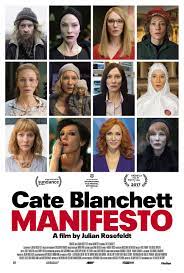
MANIFESTO
Germany, 2015, 95 minutes, Colour.
Cate Blanchett, Erica Bauer, Ruby Bustamante.
Directed by Julian Rosefeldt.
A challenging cinema experience for any audience. For devotees of arthouse cinema, there is much to interest and admire. For many audiences, Manifesto would be better appreciated with some background information.
With appreciation for the work done for this Wikipedia entry:
The film integrates various types of artist manifestos from different time periods with contemporary scenarios. Manifestos are depicted by 13 different characters, among them a school teacher, factory worker, choreographer, punk, newsreader, scientist, puppeteer, widow, and homeless man.
The film consists of 13 segments, each 10:30 minutes long. In each, a character recites parts of manifestos of various political and artistic movements.
|
No. |
Character |
Manifestos |
|
1. Prologue |
Burning fuse |
Karl Marx / Friedrich Engels, Manifesto of the Communist Party (1848) |
|
2. Situationism |
Homeless man |
Lucio Fontana, White Manifesto (1946) |
|
3. Futurism |
Broker |
Filippo Tommaso Marinetti, The Foundation and Manifesto of Futurism (1909) |
|
4. Stridentism / Creationism |
Tattooed punk |
Manuel Maples Arce, A Strident Prescription (1921) |
|
CEO at a private party |
Wassily Kandinsky / Franz Marc, "Preface to the Blue Rider Almanac" (1912) |
|
|
6. Dadaism |
Funeral speaker |
Tristan Tzara, Dada Manifesto 1918 (1918) |
|
7. Fluxus / Merz / Performance |
Choreographer |
Yvonne Rainer, No Manifesto (1965) |
|
8. Surrealism / Spatialism |
Puppeteer |
André Breton, Manifesto of Surrealism (1924) |
|
9. Architecture |
Worker in a garbage incineration plant |
Bruno Taut, Down with Seriousism! (1920) |
|
10. Suprematism / Constructivism |
Scientist |
Naum Gabo / Antoine Pevsner, The Realistic Manifesto (1920) |
|
11. Pop Art |
Conservative mother with family |
Claes Oldenburg, I am for an Art... (1961) |
|
12. Conceptual Art / Minimalism |
Newsreader and reporter |
Sol LeWitt, Paragraphs on Conceptual Art (1967) |
|
13. Film / Epilogue |
Teacher |
Stan Brakhage, Metaphors on Vision (1963) |
Production
Development
Rosefeldt began developing the project through research and analyses of an assortment of textual manifestos, starting from Karl Marx and Friedrich Engels' 1848 The Communist Manifesto and Filippo Tommaso Marinetti's 1909 The Founding and Manifesto of Futurism, the latter his first selection, to film director Jim Jarmusch's "Golden Rules of Filmmaking" (2004), the most modern text referenced.[6] Rosefeldt selected approximately 60 manifestos which he "found to be the most fascinating, and also the most requitable", or chose "because they suited one another."[6] After collating and fragmenting numerous texts, eventually 12 manifesto collages materialized.[6]
Rosefeldt said that the main concept for the project was to have a woman embody the manifestos.[6] He wanted to "make a piece in which a woman performed multiple roles" in an art-based framework.[7]
In parallel, I began to sketch different scenes in which a woman talks, ending up with sixty short scenes, situations right across various educational levels and professional milieus. The only thing these draft scenes had in common was that they are being performed today, and that a woman is holding a monologue ... Sometimes we listen to the woman's inner voice; in other instances she addresses an audience; once she even interviews herself, etc. I finally edited everything down to twelve scenes and twelve corresponding text collages.[6]